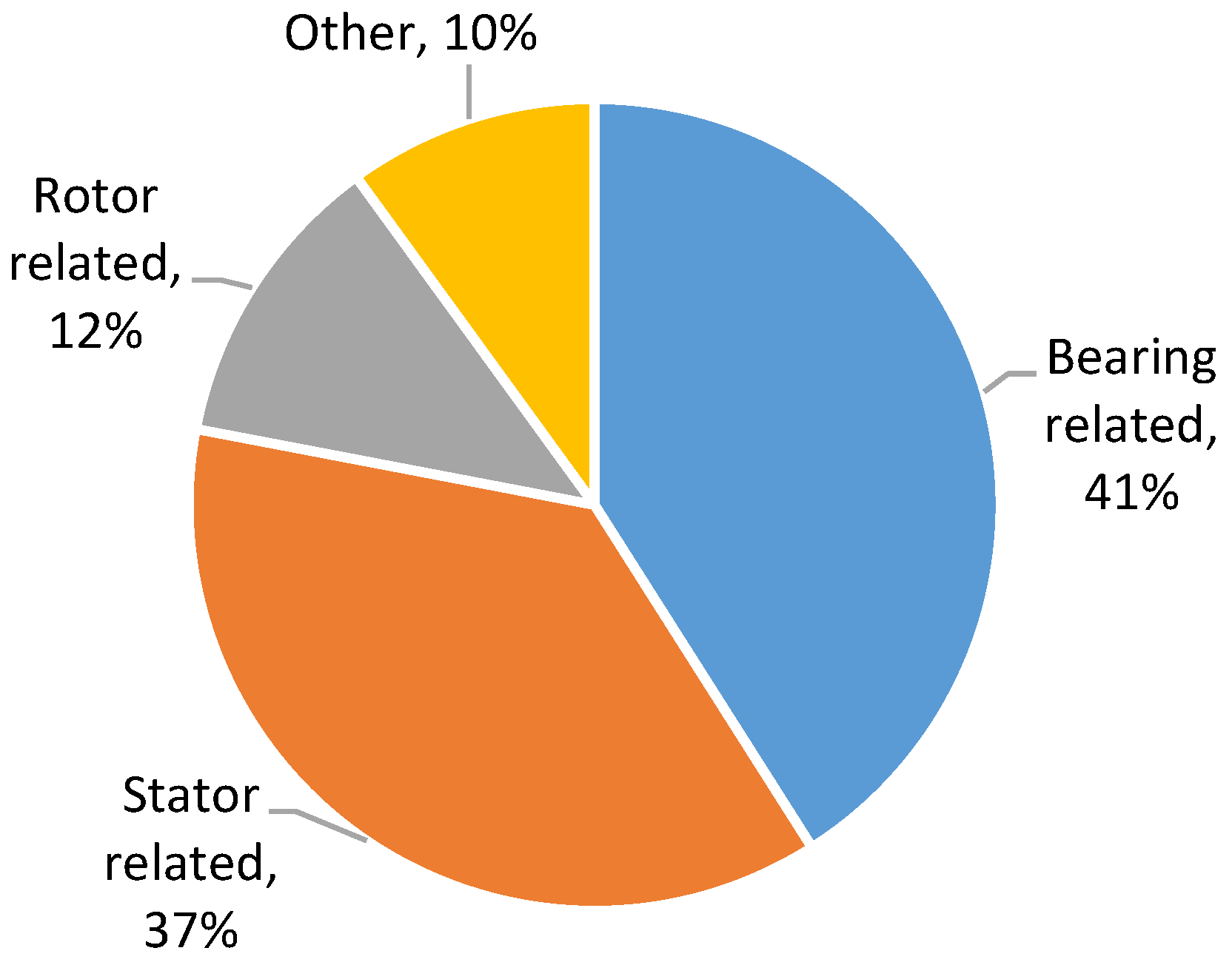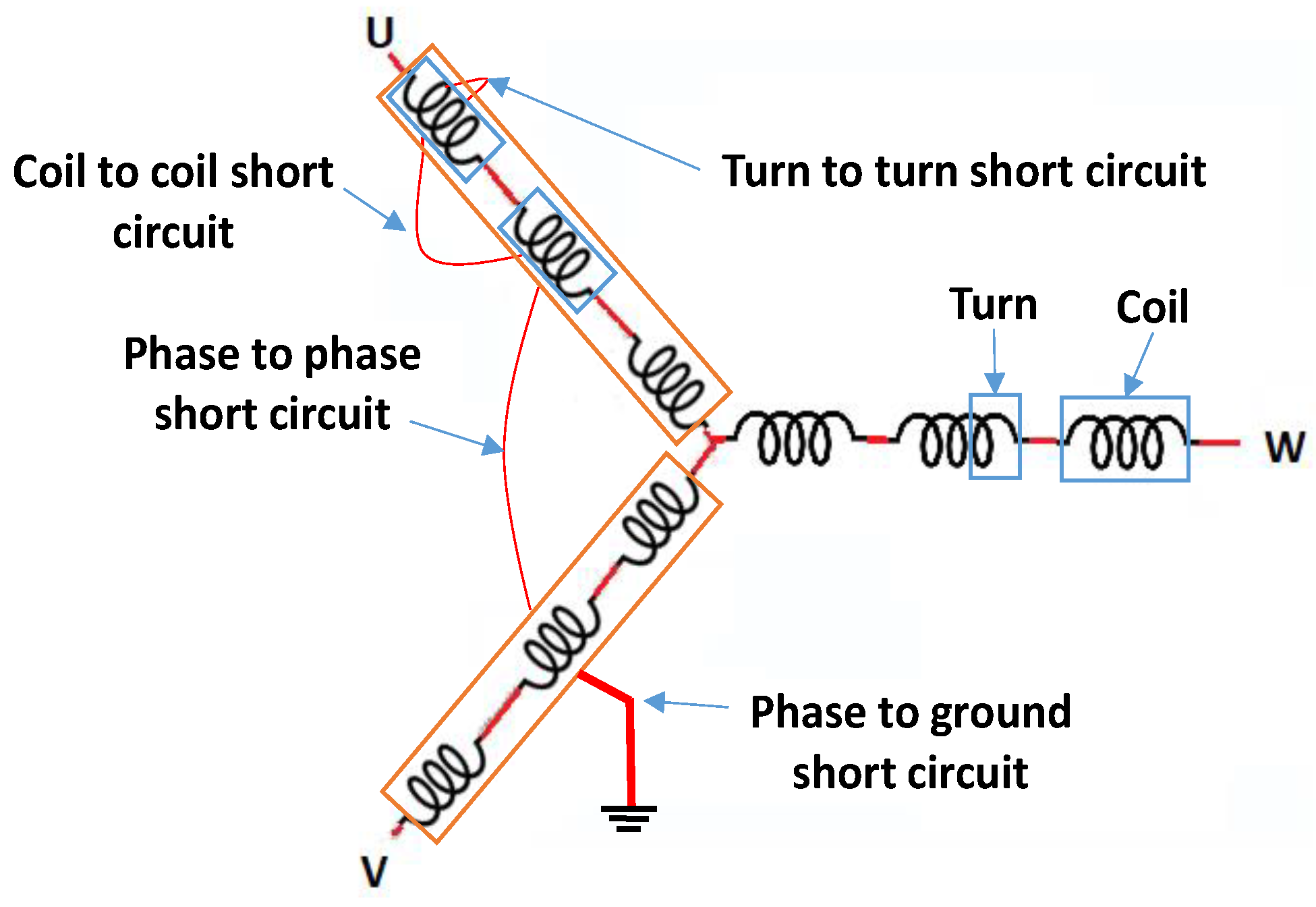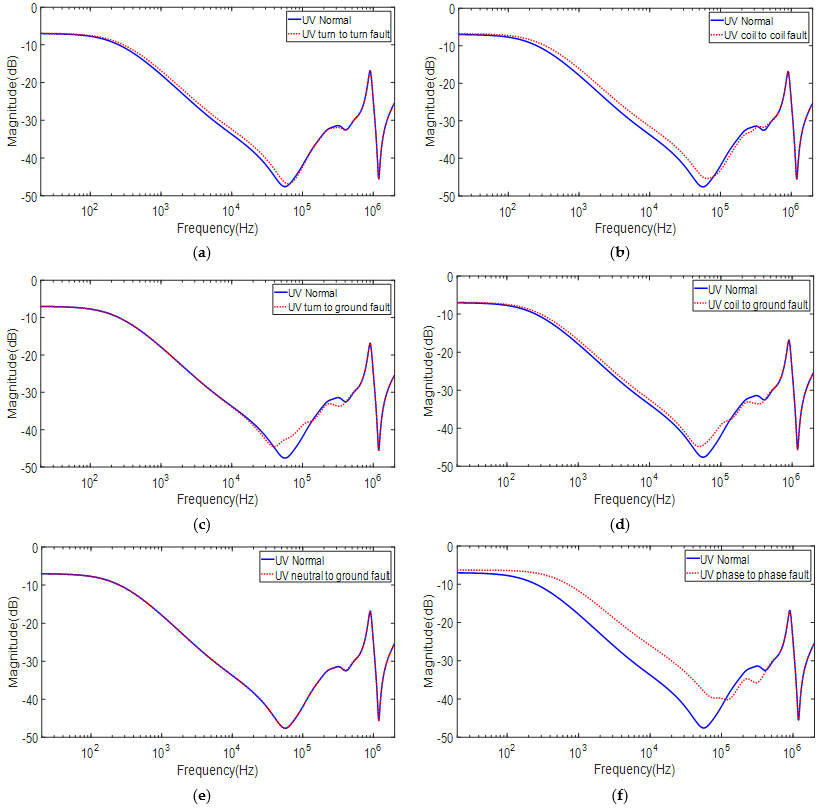Application of Frequency Response Analysis Method to Detect Short-Circuit Faults in Three-Phase Induction Motors
Abstract
:1. Introduction
- Investigating the feasibility of expanding the use of the FRA technique to detect various short circuit (SC) faults contained by rotating machines through experimental measurements.
- Understanding the influence of various TPIMs SC faults on each frequency range of the FRA signature.
- Taking one step forward to set threshold limits for statistical indicators such as CC, SD, ASLE, MSE, RMSE, DABS, Covariance, and MM to standardize the interpretation process.
2. Experimental Setup and Measurement
3. Results and Discussions
3.1. Case Study-1, 3 HP Induction Motor
3.2. Case Study-2, 1 HP Induction Motor
4. Statistical Indicators Results
5. Discussion
6. Conclusions
Author Contributions
Funding
Institutional Review Board Statement
Informed Consent Statement
Data Availability Statement
Acknowledgments
Conflicts of Interest
References
- Hsiao, C.-H.; Liu, M.-K. Failure mode analysis of induction motor model. In Proceedings of the 2017 IEEE International Conference on Applied System Innovation, Sapporo, Japan, 13–17 May 2017; pp. 25–28. [Google Scholar] [CrossRef]
- Altaf, S.; Soomro, M.W.; Mehmood, M.S. Fault Diagnosis and Detection in Industrial Motor Network Environment Using Knowledge-Level Modelling Technique. Model. Simul. Eng. 2017, 2017, 1292190. [Google Scholar] [CrossRef] [Green Version]
- Cornell, P.F.E.P.; Owen, E.L.; Appiarius, J.C.; McCoy, R.M.; Albrecht, D.W.H. Improved Motors for Utility Applications. Final Report; General Electric Co.: Schenectady, NY, USA, 1982. [Google Scholar]
- IEEE Motor Reliability Working Group. Report of Large Motor Reliability Survey of Industrial and Commercial Installations, Part I. IEEE Trans. Ind. Appl. 1985, IA-21, 853–864. [Google Scholar] [CrossRef]
- Sadeghi, R.; Samet, H.; Ghanbari, T. Detection of Stator Short-Circuit Faults in Induction Motors Using the Concept of Instantaneous Frequency. IEEE Trans. Ind. Inform. 2018, 15, 4506–4515. [Google Scholar] [CrossRef]
- Florkowski, M.; Florkowska, B.; Zydron, P. Partial Discharges in Insulating Systems of Low Voltage Electric Motors Fed by Power Electronics—Twisted-Pair Samples Evaluation. Energies 2019, 12, 768. [Google Scholar] [CrossRef] [Green Version]
- Hossain, M.L.; Abu-Siada, A.; Muyeen, S.M. Methods for Advanced Wind Turbine Condition Monitoring and Early Diagnosis: A Literature Review. Energies 2018, 11, 1309. [Google Scholar] [CrossRef] [Green Version]
- Salem, A.; Abu-Siada, A.; Islam, S. Improved Condition Monitoring Technique for Wind Turbine Gearbox and Shaft Stress Detection. IET Sci. Meas. Technol. 2017, 11, 431–437. [Google Scholar] [CrossRef]
- Shulphqwdo, Q.Q.; Vlv, Q.D.O.; Ghsduwphqw, O.Q. Condition Monitering and fault Diagnosis of Induction motor–An Experimental Analysis. In Proceedings of the 7th International Conference on Electrical Energy Systems (ICEES), Chennai, India, 11–13 February 2021; pp. 433–438. [Google Scholar]
- OMICRON. Diagnostic Testing and Monitoring of Rotating Machines. 2019. Available online: https://www.omicronenergy.com/download/document/40CEA890-3E5B-447D-BEF5-51CBE544A6E0/ (accessed on 28 October 2021).
- Yousof, M.F.M.; Alawady, A.A.; Al-Ameri, S.M.; Azis, N.; Illias, H.A. FRA Indicator Limit for Faulty Winding Assessment in Rotating Machine. In Proceedings of the 2021 IEEE International Conference on the Properties and Applications of Dielectric Materials (ICPADM), Johor Bahru, Malaysia, 12–14 July 2021; Volume 2021, pp. 346–349. [Google Scholar] [CrossRef]
- Vilhekar, T.G.; Ballal, M.S.; Umre, B.S. Application of Sweep Frequency Response Analysis for the detection of winding faults in induction motor. In Proceedings of the IECON 2016—42nd Annual Conference of the IEEE Industrial Electronics Society, Florence, Italy, 23–26 October 2016; Volume 2016, pp. 1458–1463. [Google Scholar] [CrossRef]
- Abu-Siada, A.; Hashemnia, N.; Islam, S.; Masoum, M.A. Understanding power transformer frequency response analysis signatures. IEEE Electr. Insul. Mag. 2013, 29, 48–56. [Google Scholar] [CrossRef]
- Abu-Siada, A.; Mosaad, M.I.; Kim, D.W.; El-Naggar, M.F. Estimating Power Transformer High Frequency Model Parameters Using Frequency Response Analysis. IEEE Trans. Power Deliv. 2019, 35, 1267–1277. [Google Scholar] [CrossRef]
- Yousof, M.F.M.; Al-Ameri, S.; Ahmad, H.; Illias, H.A.; Arshad, S.N.M. A New Approach for Estimating Insulation Condition of Field Transformers Using FRA. Adv. Electr. Comput. Eng. 2020, 20, 35–42. [Google Scholar] [CrossRef]
- Picher, P. Mechanical Condition Assessment of Transformer Windings Using Frequency Response Analysis (Fra). CIGRE Eval. 2008, 26, 30–34. [Google Scholar]
- IEC 60076-18 Ed.1; Power Transformers—Part 18, Measurement of Frequency Response. IEC Standard: London, UK, 2012.
- C57.149-2012; IEEE Guide for the Application and Interpretation of Frequency Response Analysis for Oil-Immersed Transformers IEEE Power and Energy Society. IEEE: Piscataway, NJ, USA, 2013. [CrossRef]
- Al-Ameri, S.; Yousof, M.F.M.; Ahmad, H.; Alsubari, M.; Talib, M.A. Examining faulty transformer tap changer using frequency response analysis. In Proceedings of the 2017 International Symposium on Electrical Insulating Materials (ISEIM), Toyohashi, Japan, 11–15 September 2017; pp. 259–262. [Google Scholar] [CrossRef]
- Cheng, B.; Wang, Z.; Crossley, P. Using Lumped Element Equivalent Network Model to Derive Analytical Equations for Interpretation of Transformer Frequency Responses. IEEE Access 2020, 8, 179486–179496. [Google Scholar] [CrossRef]
- Al-Ameri, S.; Kamarudin, M.; Yousof, M.; Salem, A.; Siada, A.; Mosaad, M. Interpretation of Frequency Response Analysis for Fault Detection in Power Transformers. Appl. Sci. 2021, 11, 2923. [Google Scholar] [CrossRef]
- Uhrig, S.; Ottl, F.; Hinterholzer, R.; Augeneder, N. Reliable Diagnostics on Rotating Machines using FRA. In The International Symposium on High Voltage Engineering; Springer: Cham, Switzerland, 2019. [Google Scholar] [CrossRef]
- Alawady, A.A.; Yousof, M.F.M.; Azis, N.; Talib, M.A. Frequency response analysis technique for induction motor short circuit faults detection. Int. J. Power Electron. Drive Syst. 2020, 11, 1653–1659. [Google Scholar] [CrossRef]
- Alawady, A.A.; Yousof, M.F.M.; Azis, N.; Talib, M.A. Phase to phase fault detection of 3-phase induction motor using FRA technique. Int. J. Power Electron. Drive Syst. 2020, 11, 1241–1248. [Google Scholar] [CrossRef]
- Brandt, M.; Kascak, S. Failure identification of induction motor using SFRA method. In Proceedings of the ELEKTRO 2016—11th International Conference, Tatry-Štrbské Pleso, Slovakia, 16–18 May 2016; pp. 269–272. [Google Scholar] [CrossRef]
- Brandt, M.; Gutten, M.; Kascak, S. Diagnostic of induction motor using SFRA method. In Proceedings of the 2016 Conference on Diagnostics in Electrical Engineering, Pilsen, Czech, 6–8 September 2016. [Google Scholar] [CrossRef]
- Alawady, A.A.; Yousof, A.F.; Azis, M.N.; Talib, A.A. Internal Fault Detection of Induction Motor using Frequency Response Analysis Technique. Int. J. Adv. Trends Comput. Sci. Eng. 2020, 9, 90–95. [Google Scholar]
- Mabrek, A.; Hemsas, K.E.; Abdelhakim, M.; Eddine, H.K. Induction motor inter-turn fault modeling and simulation using SSFR test for diagnosis purpose. Automatika 2016, 57, 948–959. [Google Scholar] [CrossRef] [Green Version]
- Fan, F.; Zhao, Z.; Tu, P.; Jie, H.; See, K.Y. Impact of Motor Stator Winding Faults on Common-Mode Current. In Proceedings of the Asia-Pacific International Symposium on Electromagnetic Compatibility (APEMC), Bali, Indonesia, 6 October 2021; pp. 1–4. [Google Scholar] [CrossRef]
- Sant’Ana, W.C.; Lambert-Torres, G.; Bonaldi, E.L.; Gama, B.R.; Zacarias, T.G.; Areias, I.A.d.S.; Arantes, D.D.A.; Assuncao, F.D.O.; Campos, M.M.; Steiner, F.M. Online Frequency Response Analysis of Electric Machinery through an Active Coupling System Based on Power Electronics. Sensors 2021, 21, 8057. [Google Scholar] [CrossRef]
- Samimi, M.H.; Tenbohlen, S.; Akmal, A.A.S.; Mohseni, H. Evaluation of numerical indices for the assessment of transformer frequency response. IET Gener. Transm. Distrib. 2017, 11, 218–227. [Google Scholar] [CrossRef]
- Al-Ameri, S.M.A.N.; Kamarudin, M.S.; Yousof, M.F.M.; Salem, A.A.; Banakhr, F.A.; Mosaad, M.I.; Abu-Siada, A. Understanding the Influence of Power Transformer Faults on the Frequency Response Signature Using Simulation Analysis and Statistical Indicators. IEEE Access 2021, 9, 70935–70947. [Google Scholar] [CrossRef]
- Sant’Ana, W.C.; Salomon, C.P.; Lambert-Torres, G.; da Silva, L.E.B.; Bonaldi, E.L.; Oliveira, L.E.D.L.D.; da Silva, J.G.B. A survey on statistical indexes applied on frequency response analysis of electric machinery and a trend based approach for more reliable results. Electr. Power Syst. Res. 2016, 137, 26–33. [Google Scholar] [CrossRef]
- Miyazaki, S.; Tahir, M.; Tenbohlen, S. Detection and quantitative diagnosis of axial displacement of transformer winding byfrequency response analysis. IET Gener. Transm. Distrib. 2019, 13, 3493–3500. [Google Scholar] [CrossRef]
- Aljohani, O.; Abu-Siada, A. Application of DIP to Detect Power Transformers Axial Displacement and Disk Space Variation Using FRA Polar Plot Signature. IEEE Trans. Ind. Inform. 2016, 13, 1794–1805. [Google Scholar] [CrossRef] [Green Version]
- Badgujar, K.; Maoyafikuddin, M.; Kulkarni, S. Alternative statistical techniques for aiding SFRA diagnostics in transformers. IET Gener. Transm. Distrib. 2012, 6, 189–198. [Google Scholar] [CrossRef]
- Hashemnia, N.; Abu-Siada, A.; Masoum, M.A.S.; Islam, S.M. Characterization of transformer FRA signature under various winding faults. In Proceedings of the 2012 IEEE International Conference on Condition Monitoring and Diagnosis, Bali, Indonesia, 23–27 September 2012; pp. 446–449. [Google Scholar] [CrossRef] [Green Version]
- Abu-Siada, A.; Aljohani, O. Detecting incipient radial deformations of power transformer windings using polar plot and digital image processing. IET Sci. Meas. Technol. 2018, 12, 492–499. [Google Scholar] [CrossRef] [Green Version]
- Behjat, V.; Mahvi, M. Statistical approach for interpretation of power transformers frequency response analysis results. IET Sci. Meas. Technol. 2015, 9, 367–375. [Google Scholar] [CrossRef]
- Ukil, A.; Chen, S.; Andenna, A. Detection of stator short circuit faults in three-phase induction motors using motor current zero crossing instants. Electr. Power Syst. Res. 2011, 81, 1036–1044. [Google Scholar] [CrossRef]








| Test | Detected Component | Purpose of Test | References |
|---|---|---|---|
| Partial discharge (PD) | Stator winding insulation | Partial discharges, insulation degradation | [6,7] |
| Tan δ | Partial discharges, insulation degradation | ||
| Vibration test | Shaft or bearing, rotor winding | The shaft or bearing vibration | [8] |
| Voltage withstand | Stator windings | Voltage withstand | [9] |
| Winding and insulation resistance | stator windings | High contact resistance and poor connections | [10] |
| Pole drop testing | Stator winding | Turns-turn faults | [11,12] |
| Frequency response analysis | |||
| Dielectric response analysis |
| Indicators | Mathematical Expression | Indicators Description | References |
|---|---|---|---|
| Correlation Coefficient (CC) | It only measures linear relationships between Xi and Yi. | [34] | |
| Absolute Sum Logarithmic Error (ASLE) | The ASLE scales the data regardless of the data size from being small or large. | [33,34,35] | |
| Standard Deviation (SD) | Similar trend as ASLE | [31] | |
| Absolute Difference (DABS) | [36,37] | ||
| Mean Square Error (MSE) | MSE magnifies errors due to the squaring operation in the equation. | [33,36] | |
| Root Mean Squared Error (RMSE) | Only sensitive to outliers | [36,37] | |
| Covariance (COVAR) | This indicator is based on a Chinese standard. | [38,39] | |
| Minimum–Maximum Ratio (MM) | MM allows comparing the similarity of a data set. | [36,37] |
| Motor | 1 | 2 |
|---|---|---|
| RPM | 2840 rpm | 1500 rpm |
| Made | JILANG | JILANG |
| Model | Y90L-2 | 110RK-3DS |
| Power rating | 2.2 kW/3 HP | 0.75 kW/1 HP |
| Voltage rating | 415 V/50 Hz | 415 V/50 Hz |
| Short Circuit Type | Statistical Indicators | |||||||||||
|---|---|---|---|---|---|---|---|---|---|---|---|---|
| CC | ASLE | SD | MSE | |||||||||
| L-F | M-F | H-F | L-F | M-F | H-F | L-F | M-F | H-F | L-F | M-F | H-F | |
| Turn-to-turn (T-T) | 0.999 | 0.999 | 0.988 | 0.907 | 1.825 | 1.757 | 1.061 | 1.826 | 2.065 | 1.126 | 3.337 | 4.265 |
| Coil-to-coil (C-C) | 0.996 | 0.999 | 0.978 | 1.712 | 3.632 | 1.526 | 2.004 | 3.636 | 2.497 | 4.016 | 13.226 | 6.236 |
| Turn-to-ground (T-G) | 1 | 0.999 | 0.990 | 0.002 | 0.016 | 1.053 | 0.003 | 0.025 | 1.414 | 0.000 | 0.000 | 1.999 |
| Coil-to-ground (C-G) | 0.999 | 0.999 | 0.978 | 0.913 | 1.890 | 1.684 | 1.066 | 1.894 | 2.110 | 1.137 | 3.588 | 4.455 |
| Neutral-to-ground (N-G) | 1 | 0.999 | 0.992 | 0.003 | 0.037 | 1.021 | 0.004 | 0.051 | 1.331 | 0.000 | 0.002 | 1.772 |
| Phase-to-phase (P-P) | 0.967 | 0.999 | 0.731 | 4.046 | 10.616 | 4.816 | 4.949 | 10.637 | 7.624 | 4.496 | 8.000 | 4.133 |
| Short Circuit Type | Statistical Indicators | |||||||||||
| DABS | RMSE | COVAR | MM | |||||||||
| L-F | M-F | H-F | L-F | M-F | H-F | L-F | M-F | H-F | L-F | M-F | H-F | |
| Turn-to-turn (T-T) | 0.907 | 1.825 | 1.757 | 1.061 | 1.826 | 2.065 | 0.051 | 0.381 | 0.025 | 1.585 | 1.065 | 1.051 |
| Coil-to-coil (C-C) | 1.712 | 3.632 | 1.526 | 2.004 | 3.636 | 2.497 | 0.042 | 0.372 | 0.006 | 1.000 | 1.139 | 1.044 |
| Turn-to-ground (T-G) | 0.002 | 0.016 | 1.053 | 0.003 | 0.025 | 1.414 | 0.061 | 0.385 | 0.032 | 1.091 | 1.000 | 1.030 |
| Coil-to-ground (C-G) | 0.913 | 1.890 | 1.684 | 1.066 | 1.894 | 2.110 | 0.051 | 0.378 | 0.016 | 1.000 | 1.067 | 1.048 |
| Neutral-to-ground (N-G) | 0.003 | 0.037 | 1.021 | 0.004 | 0.051 | 1.331 | 0.061 | 0.384 | 0.027 | 1.185 | 1.001 | 1.029 |
| Phase-to-phase (P-P) | 4.046 | 10.616 | 4.816 | 4.949 | 10.637 | 7.624 | 0.015 | 0.329 | 0.036 | 1.090 | 1.555 | 1.153 |
| Short Circuit Type | Statistical Indicators | |||||||||||
|---|---|---|---|---|---|---|---|---|---|---|---|---|
| CC | ASLE | SD | MSE | |||||||||
| L-F | M-F | H-F | L-F | M-F | H-F | L-F | M-F | H-F | L-F | M-F | H-F | |
| Turn-to-turn (T-T) | 0.999 | 0.999 | 0.995 | 0.658 | 1.288 | 0.454 | 0.754 | 1.290 | 0.762 | 0.568 | 1.665 | 0.581 |
| Coil-to-coil (C-C) | 0.999 | 0.999 | 0.983 | 1.153 | 2.166 | 0.994 | 1.294 | 2.169 | 1.449 | 1.676 | 4.708 | 2.101 |
| Turn-to-ground (T-G) | 1 | 0.999 | 0.974 | 0.004 | 0.139 | 1.091 | 0.004 | 0.199 | 1.815 | 0.000 | 0.039 | 3.296 |
| Coil-to-ground (C-G) | 0.999 | 0.999 | 0.988 | 0.696 | 1.224 | 0.981 | 0.779 | 1.224 | 1.450 | 0.607 | 1.498 | 2.105 |
| Neutral-to-ground (N-G) | 1 | 1 | 0.999 | 0.003 | 0.001 | 0.042 | 0.004 | 0.002 | 0.075 | 0.000 | 0.000 | 0.005 |
| Phase-to-phase (P-P) | 0.985 | 0.999 | 0.802 | 3.772 | 7.565 | 3.100 | 4.310 | 7.571 | 4.785 | 4.582 | 8.329 | 4.89 |
| Short Circuit Type | Statistical Indicators | |||||||||||
| DABS | RMSE | COVAR | MM | |||||||||
| L-F | M-F | H-F | L-F | M-F | H-F | L-F | M-F | H-F | L-F | M-F | H-F | |
| Turn-to-turn (T-T) | 0.658 | 1.288 | 0.454 | 0.754 | 1.290 | 0.762 | 0.088 | 0.284 | 0.021 | 1.054 | 1.043 | 1.013 |
| Coil-to-coil (C-C) | 1.153 | 2.166 | 0.994 | 1.294 | 2.169 | 1.449 | 0.082 | 0.281 | 0.014 | 1.100 | 1.075 | 1.029 |
| Turn-to-ground (T-G) | 0.004 | 0.139 | 1.091 | 0.004 | 0.199 | 1.815 | 0.099 | 0.293 | 0.039 | 1.000 | 1.004 | 1.032 |
| Coil-to-ground (C-G) | 0.696 | 1.224 | 0.981 | 0.779 | 1.224 | 1.450 | 0.088 | 0.286 | 0.025 | 1.058 | 1.041 | 1.029 |
| Neutral-to-ground (N-G) | 0.003 | 0.001 | 0.042 | 0.004 | 0.002 | 0.075 | 0.098 | 0.288 | 0.031 | 1.000 | 1.000 | 1.001 |
| Phase-to-phase (P-P) | 3.772 | 7.565 | 3.100 | 4.310 | 7.571 | 4.785 | 0.045 | 0.266 | 0.020 | 1.423 | 1.324 | 1.096 |
Publisher’s Note: MDPI stays neutral with regard to jurisdictional claims in published maps and institutional affiliations. |
© 2022 by the authors. Licensee MDPI, Basel, Switzerland. This article is an open access article distributed under the terms and conditions of the Creative Commons Attribution (CC BY) license (https://creativecommons.org/licenses/by/4.0/).
Share and Cite
Al-Ameri, S.M.; Alawady, A.A.; Yousof, M.F.M.; Kamarudin, M.S.; Salem, A.A.; Abu-Siada, A.; Mosaad, M.I. Application of Frequency Response Analysis Method to Detect Short-Circuit Faults in Three-Phase Induction Motors. Appl. Sci. 2022, 12, 2046. https://doi.org/10.3390/app12042046
Al-Ameri SM, Alawady AA, Yousof MFM, Kamarudin MS, Salem AA, Abu-Siada A, Mosaad MI. Application of Frequency Response Analysis Method to Detect Short-Circuit Faults in Three-Phase Induction Motors. Applied Sciences. 2022; 12(4):2046. https://doi.org/10.3390/app12042046
Chicago/Turabian StyleAl-Ameri, Salem Mgammal, Ahmed Allawy Alawady, Mohd Fairouz Mohd Yousof, Muhammad Saufi Kamarudin, Ali Ahmed Salem, Ahmed Abu-Siada, and Mohamed I. Mosaad. 2022. "Application of Frequency Response Analysis Method to Detect Short-Circuit Faults in Three-Phase Induction Motors" Applied Sciences 12, no. 4: 2046. https://doi.org/10.3390/app12042046
APA StyleAl-Ameri, S. M., Alawady, A. A., Yousof, M. F. M., Kamarudin, M. S., Salem, A. A., Abu-Siada, A., & Mosaad, M. I. (2022). Application of Frequency Response Analysis Method to Detect Short-Circuit Faults in Three-Phase Induction Motors. Applied Sciences, 12(4), 2046. https://doi.org/10.3390/app12042046










